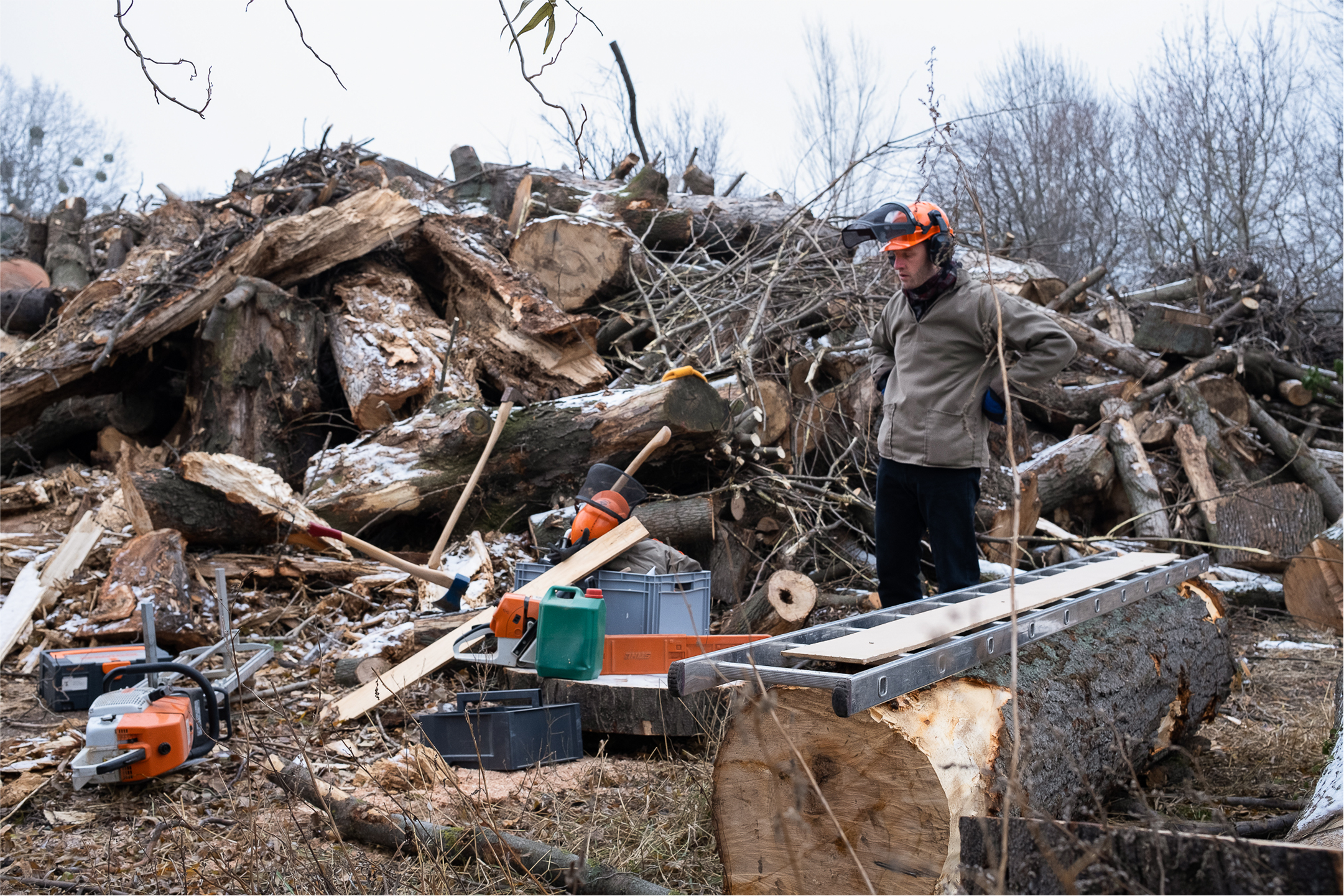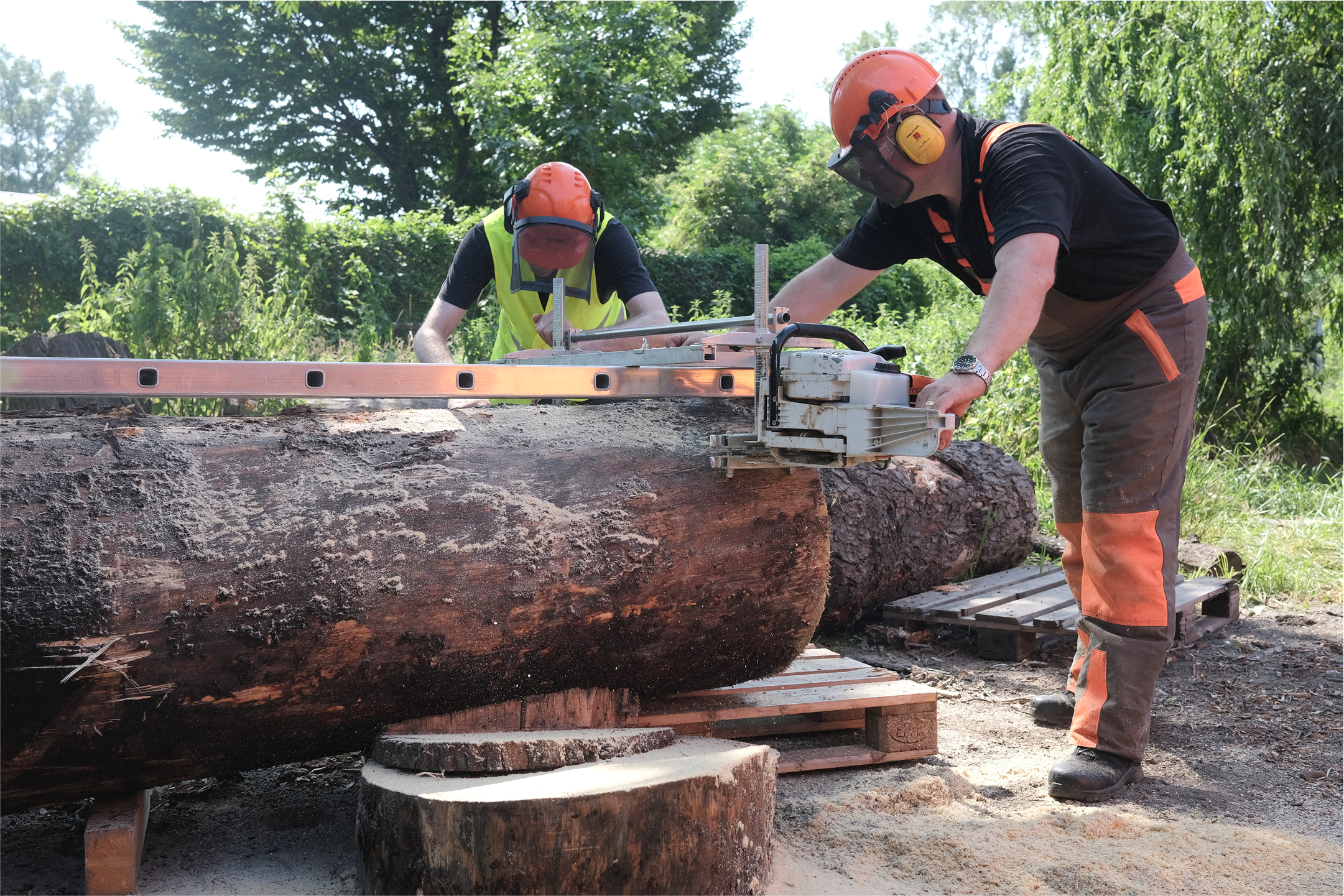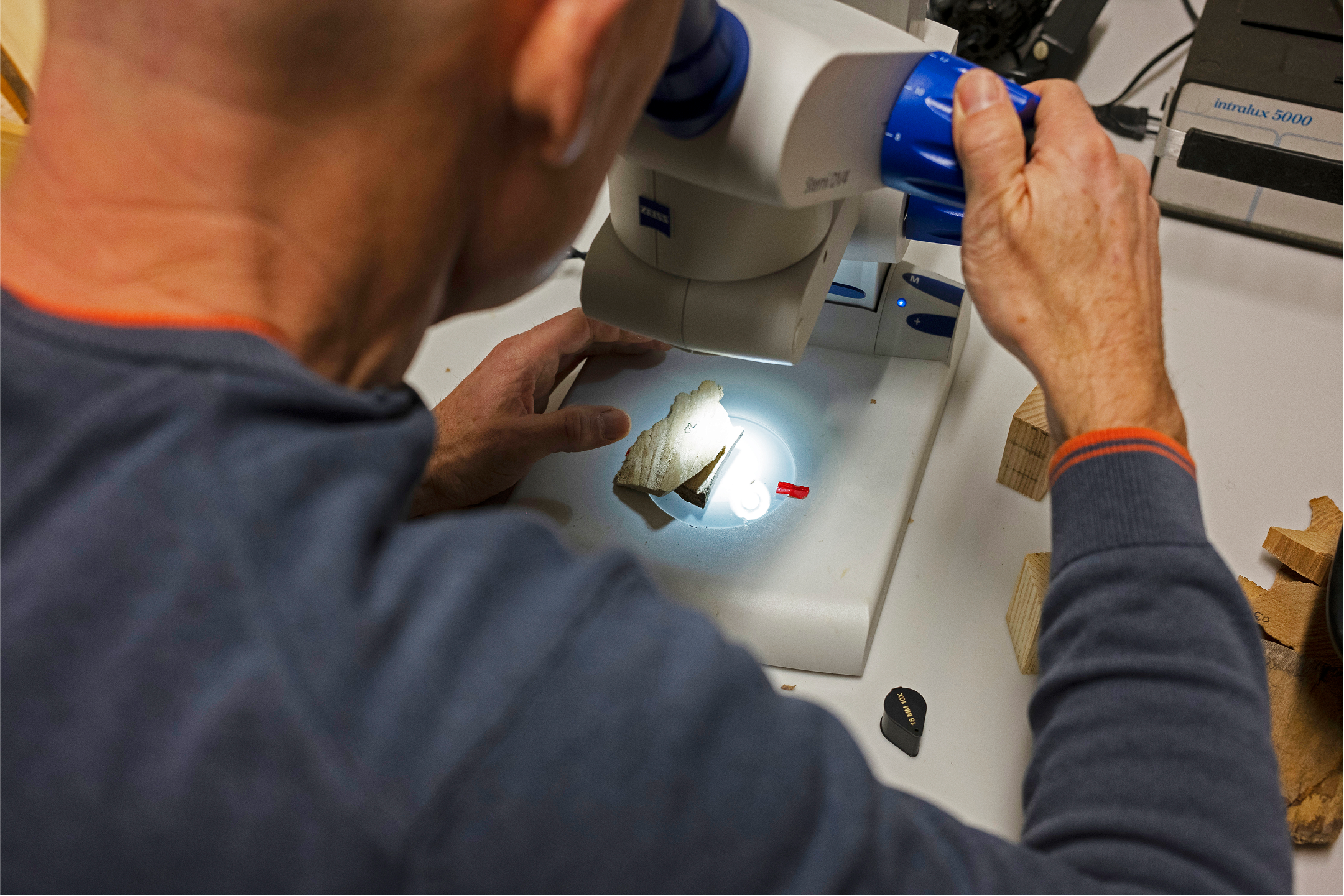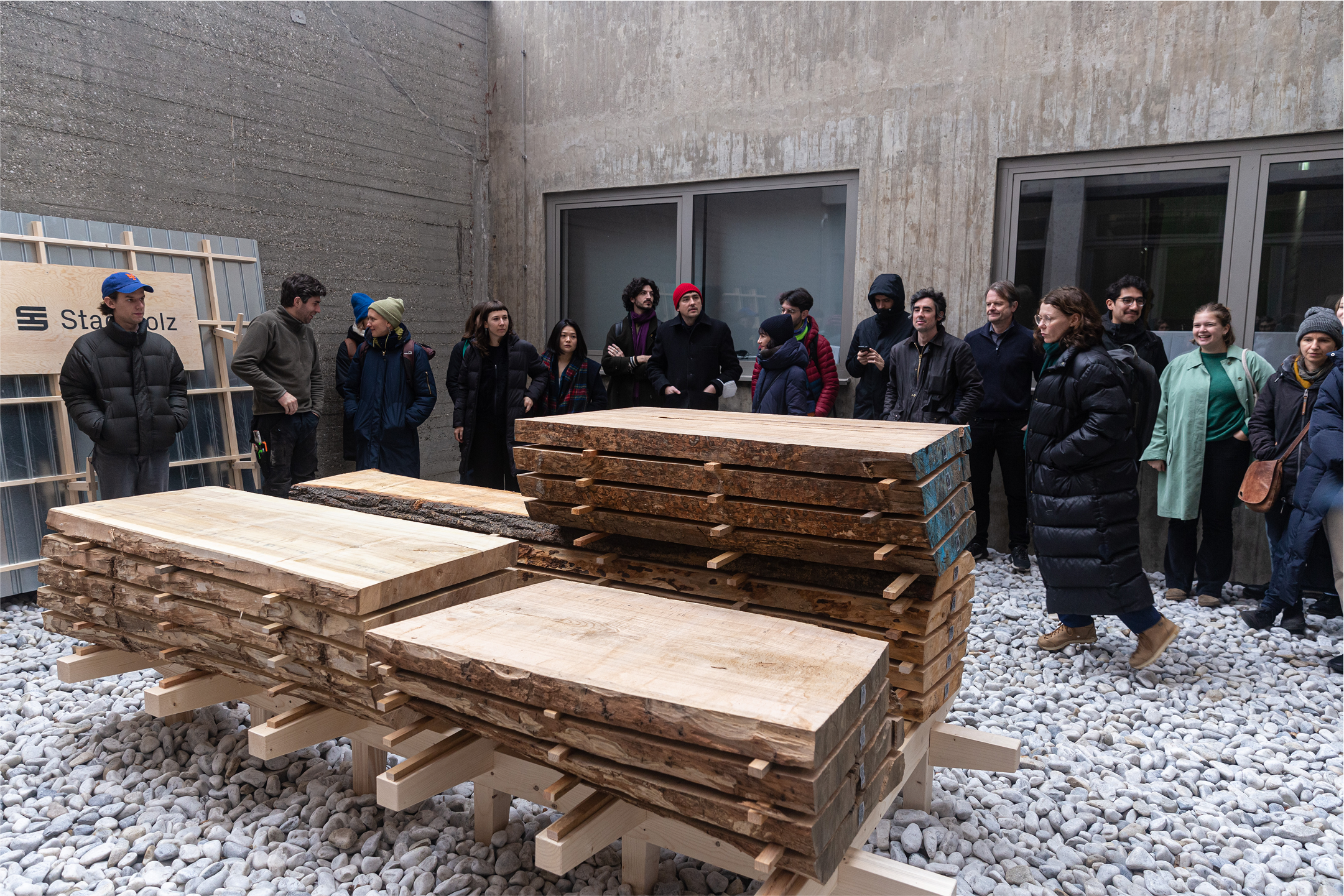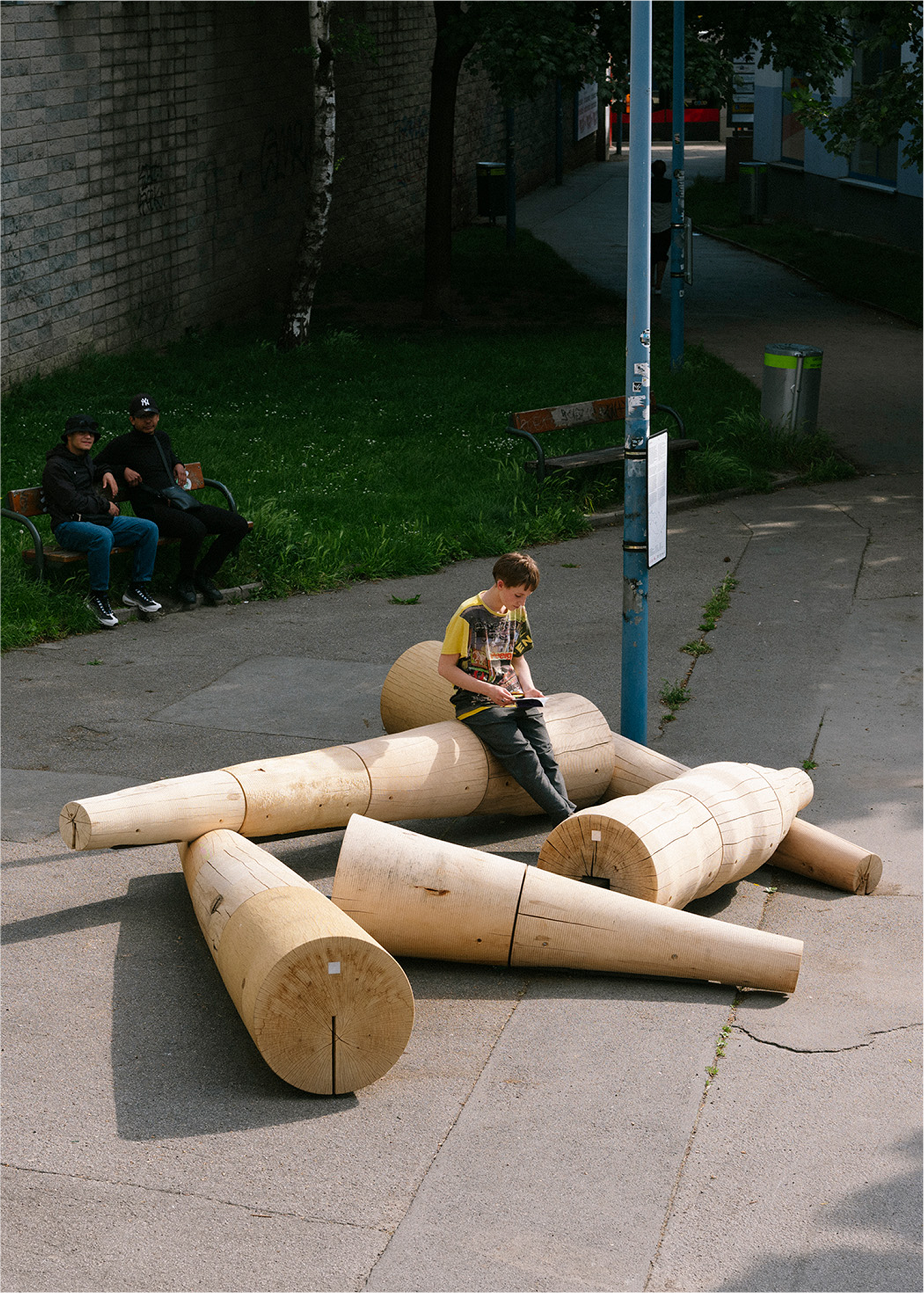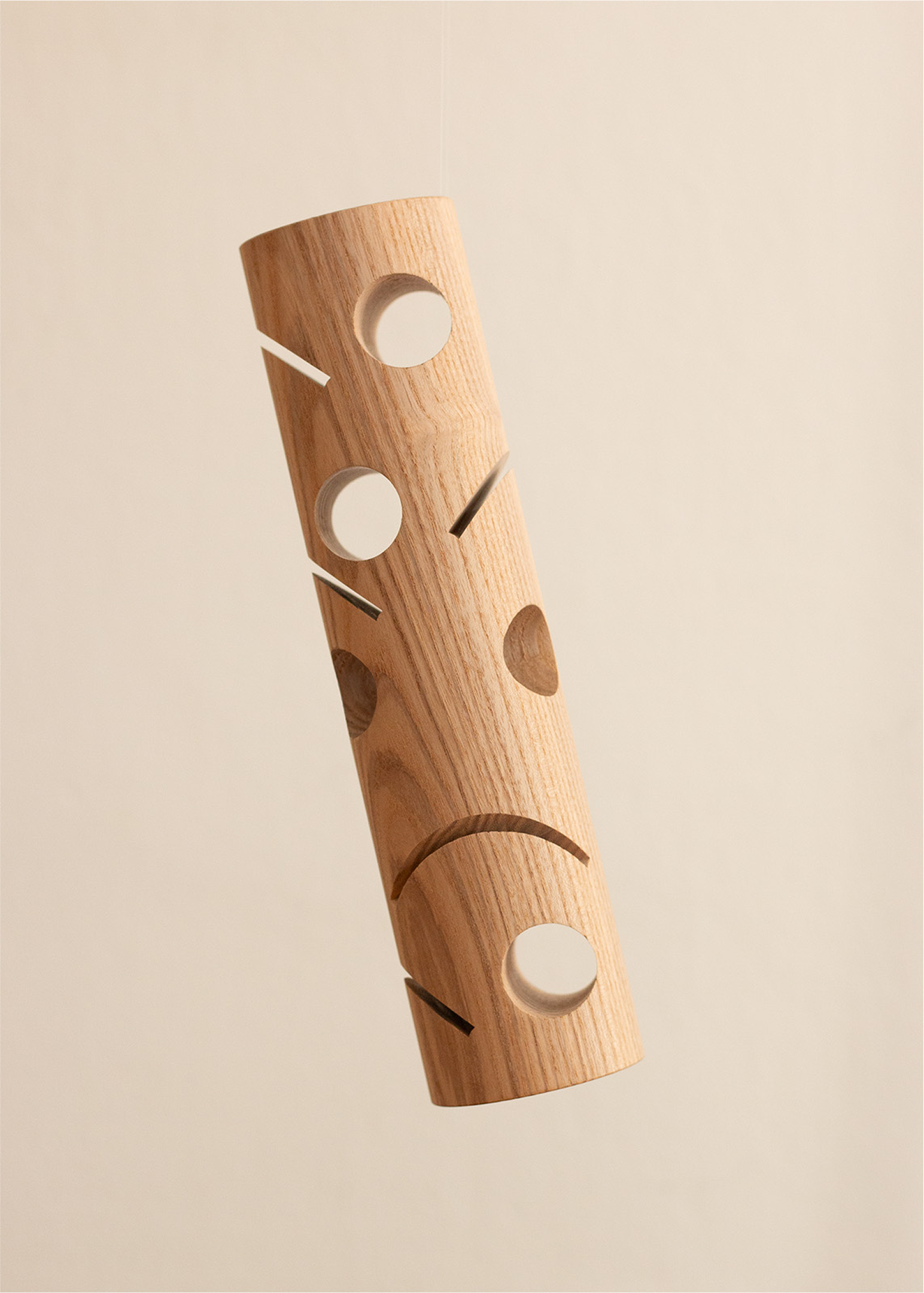Shaping a circular industrial ecosystem and supporting life-cycle thinking
Stadtholz
Stadtholz. Transforming Vienna's urban timber into valuable resources for a circular economy.
Stadtholz transforms Vienna’s felled urban trees into valuable resources for art, design and public use. In collaboration with municipal authorities, we rescue quality wood that would otherwise be discarded, giving it new life and preserving its environmental value. By reimagining these trees, we unlock possibilities for a circular economy, showcasing how local materials can drive sustainable innovation.
Austria
Local
Vienna
Mainly urban
It refers to a physical transformation of the built environment (hard investment)
Yes
2024-12-25
No
No
No
As a representative of an organisation
Stadtholz is a circular urban wood initiative that repurposes felled city trees into high-value materials for design, craftsmanship, and public space enhancement. Over the past two years, it has successfully processed materials, produced products, and expanded its impact. By salvaging trees that would otherwise become waste, Stadtholz extends their lifecycle, reduces environmental impact, and promotes urban material reuse.
Aim
Stadtholz recovers felled trees, reintegrating them into creative, functional, and ecological applications. A digital traceability system ensures transparency in tree felling and material reuse, while promoting public awareness and strengthening the connection to urban nature.
Stadtholz embodies sustainability by reducing wood waste, aesthetics by transforming salvaged trees into design objects, and inclusion by providing reclaimed materials to local artists and craftsmen.
Target Groups & Community Impact
Craftsmen, artists, and designers seeking sustainable, locally sourced wood.
Municipalities and institutions seeking circular urban solutions.
Environmental organizations and researchers exploring circular economy models.
The public, benefiting from improved spaces and educational initiatives.
Objectives & Outcomes
Stadtholz partnered with Vienna’s City Gardens Department (MA42) for access to felled trees and established a drying rack. In collaboration with BOKU University, the project tested kiln drying methods and developed a traceability system. The project has created urban furniture, art installations, and commissioned works (e.g., Caritas trophies), while providing materials to local artists and organizing exhibitions and public events.
By combining research, municipal collaboration, and creative reuse, Stadtholz ensures urban wood remains a valuable resource, benefiting both people and the environment.
Aim
Stadtholz recovers felled trees, reintegrating them into creative, functional, and ecological applications. A digital traceability system ensures transparency in tree felling and material reuse, while promoting public awareness and strengthening the connection to urban nature.
Stadtholz embodies sustainability by reducing wood waste, aesthetics by transforming salvaged trees into design objects, and inclusion by providing reclaimed materials to local artists and craftsmen.
Target Groups & Community Impact
Craftsmen, artists, and designers seeking sustainable, locally sourced wood.
Municipalities and institutions seeking circular urban solutions.
Environmental organizations and researchers exploring circular economy models.
The public, benefiting from improved spaces and educational initiatives.
Objectives & Outcomes
Stadtholz partnered with Vienna’s City Gardens Department (MA42) for access to felled trees and established a drying rack. In collaboration with BOKU University, the project tested kiln drying methods and developed a traceability system. The project has created urban furniture, art installations, and commissioned works (e.g., Caritas trophies), while providing materials to local artists and organizing exhibitions and public events.
By combining research, municipal collaboration, and creative reuse, Stadtholz ensures urban wood remains a valuable resource, benefiting both people and the environment.
Circular economy
Urban Wood Recovery
Material traceability
Sustainable Design
Community Engagement
Stadtholz advances urban wood circularity by salvaging felled trees and repurposing them into long-lasting applications, preventing resource waste. The project emphasizes resource efficiency, carbon retention, and ecological awareness, creating a scalable, sustainable model for cities.
Preventing Waste & Extending Lifecycle – Over 20 tree stems have been salvaged, with 10+ processed for natural drying and kiln drying tested with BOKU University.
Material Traceability – Each tree’s provenance, species, and processing details are documented, using visual timber examination for species identification.
Low-Impact Processing & Local Sourcing – Logs are sawn on-site, reducing transport emissions. Natural drying lowers energy use, while kiln drying is optimized for efficiency. Sourcing local wood reduces reliance on imports, minimizing deforestation.
Biodiversity & Public Spaces – Stadtholz develops modular animal habitats and public furniture, integrating urban wood into ecological designs that support biodiversity.
Community Awareness & Long-Term Impact – Through workshops, exhibitions, and public engagement, Stadtholz educates the public while fostering a local, circular economy.
Exemplary Impact
Stadtholz demonstrates urban wood’s potential in circular economy models, offering a replicable, scalable solution that benefits both people and the environment.
Preventing Waste & Extending Lifecycle – Over 20 tree stems have been salvaged, with 10+ processed for natural drying and kiln drying tested with BOKU University.
Material Traceability – Each tree’s provenance, species, and processing details are documented, using visual timber examination for species identification.
Low-Impact Processing & Local Sourcing – Logs are sawn on-site, reducing transport emissions. Natural drying lowers energy use, while kiln drying is optimized for efficiency. Sourcing local wood reduces reliance on imports, minimizing deforestation.
Biodiversity & Public Spaces – Stadtholz develops modular animal habitats and public furniture, integrating urban wood into ecological designs that support biodiversity.
Community Awareness & Long-Term Impact – Through workshops, exhibitions, and public engagement, Stadtholz educates the public while fostering a local, circular economy.
Exemplary Impact
Stadtholz demonstrates urban wood’s potential in circular economy models, offering a replicable, scalable solution that benefits both people and the environment.
Stadtholz was initiated at the University of Applied Arts Vienna, and today, over half of our core team consists of design experts. Aesthetic values are embedded in the project’s DNA, shaping both material use and final creations.
Stadtholz has produced urban furniture, art installations, and commissioned works (e.g., handcrafted trophies), highlighting the unique properties of Vienna’s urban trees.
Each piece retains the wood’s natural identity, showcasing its grain, form, and history, rather than treating it as an anonymous material, adding a narrative dimension to design.
By integrating urban wood into public space improvements, Stadtholz reconnects people with local materials.
Stadtholz fosters collaboration between designers, carpenters, and artists, blending traditional woodworking with contemporary circular economy models.
We uphold high visual standards in photography, exhibitions, and outreach, reinforcing Stadtholz’s identity and shifting public perception from waste to beauty.
Exemplary Impact
Stadtholz serves as an exemplary model of how circular resource management can elevate aesthetics in urban environments. By using locally available wood for high-quality design, the project challenges mass-production norms and demonstrates that circular materials can be beautiful, durable, and culturally meaningful.
Stadtholz has produced urban furniture, art installations, and commissioned works (e.g., handcrafted trophies), highlighting the unique properties of Vienna’s urban trees.
Each piece retains the wood’s natural identity, showcasing its grain, form, and history, rather than treating it as an anonymous material, adding a narrative dimension to design.
By integrating urban wood into public space improvements, Stadtholz reconnects people with local materials.
Stadtholz fosters collaboration between designers, carpenters, and artists, blending traditional woodworking with contemporary circular economy models.
We uphold high visual standards in photography, exhibitions, and outreach, reinforcing Stadtholz’s identity and shifting public perception from waste to beauty.
Exemplary Impact
Stadtholz serves as an exemplary model of how circular resource management can elevate aesthetics in urban environments. By using locally available wood for high-quality design, the project challenges mass-production norms and demonstrates that circular materials can be beautiful, durable, and culturally meaningful.
Stadtholz fosters inclusion through accessibility, affordability, and community participation, ensuring urban wood becomes a shared resource rather than waste.
We provide free reclaimed wood to artists and designers, lowering barriers to sustainable materials. Material availability is communicated via social media and direct outreach, enabling flexible access. The project operates as an open association, engaging craftsmen, environmentalists, and institutions in shaping urban wood recovery.
By repurposing salvaged wood into public furniture and biodiversity-supporting structures, Stadtholz enhances Vienna’s public spaces for wider community benefit. Through exhibitions, workshops, and events, we promote circular material use and sustainable forestry, making sustainability more visible and participatory.
By integrating free access, open collaboration, and public engagement, Stadtholz sets a precedent for inclusive, circular resource management.
We provide free reclaimed wood to artists and designers, lowering barriers to sustainable materials. Material availability is communicated via social media and direct outreach, enabling flexible access. The project operates as an open association, engaging craftsmen, environmentalists, and institutions in shaping urban wood recovery.
By repurposing salvaged wood into public furniture and biodiversity-supporting structures, Stadtholz enhances Vienna’s public spaces for wider community benefit. Through exhibitions, workshops, and events, we promote circular material use and sustainable forestry, making sustainability more visible and participatory.
By integrating free access, open collaboration, and public engagement, Stadtholz sets a precedent for inclusive, circular resource management.
Stadtholz actively engages citizens and civil society by making urban wood accessible, fostering creative reuse, and raising environmental awareness. Our initiative benefits local artists, designers, and the public by transforming reclaimed wood into functional, cultural, and educational resources.
Role & Level of Involvement
Providing Free Access to Materials
Artists and craftspeople receive free salvaged wood, enabling them to create sustainable design pieces, public art, and furniture. We have assisted multiple artists and students in selecting the right wood for their projects, ensuring optimal use of reclaimed materials.
Public Art & Community Integration
The project Umdrehen (Turn Over) by Stadtholz co-founders Dóra Medvecky and Fabio Spink demonstrates how reclaimed urban wood can be transformed into a public art object. This installation functioned as both urban furniture and a data visualization, using timber to represent tree statistics. Installed in Floridsdorf, a district of Vienna, Umdrehen was well received by residents, highlighting the potential of urban wood in public spaces.
Public Engagement & Education
Stadtholz participates in major cultural and sustainability events, such as Caritas Innovation Festival and Vienna Design Week, where we educate the public through exhibitions, workshops, and discussions on urban wood recovery and circular design.
Shifting public perception has raised awareness of urban trees as a reusable resource, changing how people view wood waste. This also strengthens creative industries by supporting artists and designers in using sustainable materials. Projects like Umdrehen have demonstrated urban wood’s practical applications, inspiring more collaborations and its integration into city planning. Through open access, artistic collaboration, and public engagement, Stadtholz shows how urban wood recovery drives community-driven sustainability.
Role & Level of Involvement
Providing Free Access to Materials
Artists and craftspeople receive free salvaged wood, enabling them to create sustainable design pieces, public art, and furniture. We have assisted multiple artists and students in selecting the right wood for their projects, ensuring optimal use of reclaimed materials.
Public Art & Community Integration
The project Umdrehen (Turn Over) by Stadtholz co-founders Dóra Medvecky and Fabio Spink demonstrates how reclaimed urban wood can be transformed into a public art object. This installation functioned as both urban furniture and a data visualization, using timber to represent tree statistics. Installed in Floridsdorf, a district of Vienna, Umdrehen was well received by residents, highlighting the potential of urban wood in public spaces.
Public Engagement & Education
Stadtholz participates in major cultural and sustainability events, such as Caritas Innovation Festival and Vienna Design Week, where we educate the public through exhibitions, workshops, and discussions on urban wood recovery and circular design.
Shifting public perception has raised awareness of urban trees as a reusable resource, changing how people view wood waste. This also strengthens creative industries by supporting artists and designers in using sustainable materials. Projects like Umdrehen have demonstrated urban wood’s practical applications, inspiring more collaborations and its integration into city planning. Through open access, artistic collaboration, and public engagement, Stadtholz shows how urban wood recovery drives community-driven sustainability.
Stadtholz is a locally driven association that integrates key stakeholders from municipal, academic, creative, and public sectors to establish a circular urban wood recovery model.
Local Level (Core Design & Implementation Partners):
Vienna’s City Gardens Department (MA42): Provides access to felled urban trees, embedding Stadtholz within municipal circular economy strategies.
Executive City Councillor for Climate & Environment: Supports Stadtholz’s alignment with Vienna’s sustainability policies.
BOKU University: Contributes scientific expertise on wood drying and sustainable processing, optimizing material recovery.
Angewandte University: Supplied technical woodwork equipment in the initial phases, enabling early prototyping.
Local Artists, Designers & Craftspeople: Transform reclaimed wood into functional, artistic, and architectural applications.
Public Engagement: Through exhibitions, workshops, and awareness campaigns, Stadtholz fosters community participation and education.
This multi-stakeholder collaboration ensures a comprehensive approach, combining technical expertise, municipal support, creative application, and public engagement. The involvement of these stakeholders makes Stadtholz a scalable model for sustainable urban wood recovery. Furthermore, Stadtholz maintains horizontal connections and informal knowledge exchanges with organizations across Europe and beyond, fostering shared learning in urban forestry and circular material use.
Local Level (Core Design & Implementation Partners):
Vienna’s City Gardens Department (MA42): Provides access to felled urban trees, embedding Stadtholz within municipal circular economy strategies.
Executive City Councillor for Climate & Environment: Supports Stadtholz’s alignment with Vienna’s sustainability policies.
BOKU University: Contributes scientific expertise on wood drying and sustainable processing, optimizing material recovery.
Angewandte University: Supplied technical woodwork equipment in the initial phases, enabling early prototyping.
Local Artists, Designers & Craftspeople: Transform reclaimed wood into functional, artistic, and architectural applications.
Public Engagement: Through exhibitions, workshops, and awareness campaigns, Stadtholz fosters community participation and education.
This multi-stakeholder collaboration ensures a comprehensive approach, combining technical expertise, municipal support, creative application, and public engagement. The involvement of these stakeholders makes Stadtholz a scalable model for sustainable urban wood recovery. Furthermore, Stadtholz maintains horizontal connections and informal knowledge exchanges with organizations across Europe and beyond, fostering shared learning in urban forestry and circular material use.
Stadtholz combines design, craftsmanship, environmental sciences, and digital technology to create sustainable applications for urban wood, ensuring ecological responsibility, material traceability, and innovative solutions.
Key Disciplines & Contributions:
Craftsmanship & Woodwork – Fabio Spink (Industrial Designer & Carpenter) ensures precise wood processing.
Architecture & Design – Dora Medveczky (Architect & Furniture Designer) shapes the project’s creative trajectory.
Digital Infrastructure – Orest Yaremchuk (Graphic & Digital Designer) develops visual identity and a wood traceability database.
Environmental Science – Bernd Rokita (Environmental Expert) ensures sustainable tree species selection.
Videography – Florian Kläger supports visual documentation.
Collaborations:
Prof. Wolfgang Gindl-Altmutter (BOKU) – Expert in wood identification.
Johannes Hoffman (Academy of Arts, Vienna) – Technical expertise in woodworking.
Philipp Frei (Angewandte Robotic Lab) – Applied KUKA robots for fabrication.
MA42, City Gardens Department – Provides experience in wood felling and ongoing communication with Stadtholz about how the city manages wood waste.
Added Value:
The integration of these fields ensures a sustainable, creative process. Experts like Fabio and Bernd ensure responsible wood sourcing and processing, while Dora and Orest enhance design and digital tools for practical applications. Collaborations with BOKU, Angewandte, and MA42 provide access to cutting-edge research, technology, and municipal expertise in managing wood waste. This interdisciplinary approach maximizes material reuse, minimizes environmental impact, and results in innovative, culturally significant solutions.
Key Disciplines & Contributions:
Craftsmanship & Woodwork – Fabio Spink (Industrial Designer & Carpenter) ensures precise wood processing.
Architecture & Design – Dora Medveczky (Architect & Furniture Designer) shapes the project’s creative trajectory.
Digital Infrastructure – Orest Yaremchuk (Graphic & Digital Designer) develops visual identity and a wood traceability database.
Environmental Science – Bernd Rokita (Environmental Expert) ensures sustainable tree species selection.
Videography – Florian Kläger supports visual documentation.
Collaborations:
Prof. Wolfgang Gindl-Altmutter (BOKU) – Expert in wood identification.
Johannes Hoffman (Academy of Arts, Vienna) – Technical expertise in woodworking.
Philipp Frei (Angewandte Robotic Lab) – Applied KUKA robots for fabrication.
MA42, City Gardens Department – Provides experience in wood felling and ongoing communication with Stadtholz about how the city manages wood waste.
Added Value:
The integration of these fields ensures a sustainable, creative process. Experts like Fabio and Bernd ensure responsible wood sourcing and processing, while Dora and Orest enhance design and digital tools for practical applications. Collaborations with BOKU, Angewandte, and MA42 provide access to cutting-edge research, technology, and municipal expertise in managing wood waste. This interdisciplinary approach maximizes material reuse, minimizes environmental impact, and results in innovative, culturally significant solutions.
Stadtholz challenges mainstream urban forestry practices in Vienna, where felled city trees are typically downcycled into mulch or compost, missing their material and cultural potential. While urban wood recovery exists globally, particularly in the US, our project introduces the first structured approach to creative wood reuse in Vienna's municipal system.
Our innovation lies in successfully integrating a small-scale, high-attention recovery process within existing municipal infrastructure. Unlike large-scale operations that prioritize volume, Stadtholz's focused approach allows careful assessment of individual trees' potential. This complementary model demonstrates how non-profit organizations can enhance existing systems to achieve higher-value material recovery.
We've developed a distinctive marking and documentation system tracking each piece of wood from urban origin through final use. This granular traceability, unprecedented in Vienna's urban forestry, ensures every material carries its complete story—making sustainability tangible and accountable.
Through our official agreement with Vienna's City Gardens Department (MA42), we've established a new governance model bridging urban forestry, sustainability policies, and creative industries. What sets Stadtholz apart is our design-first approach to material recovery. Unlike traditional wood recycling focused primarily on processing, we prioritize creative potential and cultural value in our recovery decisions.
By providing free access to salvaged materials for artists and designers, we've created a unique model that democratizes sustainable design and enables a cultural shift towards regenerative, local material use. This combination of careful material selection, detailed traceability, municipal collaboration, and design-led thinking demonstrates how focused interventions can complement existing systems to create higher value from urban resources.
Our innovation lies in successfully integrating a small-scale, high-attention recovery process within existing municipal infrastructure. Unlike large-scale operations that prioritize volume, Stadtholz's focused approach allows careful assessment of individual trees' potential. This complementary model demonstrates how non-profit organizations can enhance existing systems to achieve higher-value material recovery.
We've developed a distinctive marking and documentation system tracking each piece of wood from urban origin through final use. This granular traceability, unprecedented in Vienna's urban forestry, ensures every material carries its complete story—making sustainability tangible and accountable.
Through our official agreement with Vienna's City Gardens Department (MA42), we've established a new governance model bridging urban forestry, sustainability policies, and creative industries. What sets Stadtholz apart is our design-first approach to material recovery. Unlike traditional wood recycling focused primarily on processing, we prioritize creative potential and cultural value in our recovery decisions.
By providing free access to salvaged materials for artists and designers, we've created a unique model that democratizes sustainable design and enables a cultural shift towards regenerative, local material use. This combination of careful material selection, detailed traceability, municipal collaboration, and design-led thinking demonstrates how focused interventions can complement existing systems to create higher value from urban resources.
Methodology & Approach of Stadtholz
Stadtholz employs a holistic, circular approach to urban wood recovery, integrating material sustainability, traceability, design innovation, and community engagement. Our methodology is structured around four key phases, and as a small, enthusiasm-driven organization with limited funding, we rely on modular, mobile solutions and university partnerships for equipment and logistics.
Urban Wood Recovery & Processing:
We identify and salvage felled trees from Vienna’s urban landscape, in collaboration with Vienna’s City Gardens Department (MA42). Logs are sawn into boards at a sorting facility and stored in a natural drying rack for low-energy treatment. In partnership with BOKU University, we have also experimented with kiln drying to refine processing techniques.
Traceability & Transparency:
Each salvaged tree is meticulously documented, including its location, species, felling date, and processing details. Tree species are identified using visual timber examination, a technique from BOKU’s Institute for Wood Technology. This ensures material traceability, allowing designers, artists, and users to understand the wood’s provenance and ecological value.
Design & Application:
Reclaimed wood is transformed into urban furniture, art installations, and commissioned works, promoting sustainable craftsmanship. We collaborate with local designers, architects, and artists to create site-specific, culturally relevant applications of urban wood.
Community Engagement & Awareness:
We organize exhibitions, workshops, and events to educate the public on urban forestry, circular design, and waste reduction. Through our social media channels, we share project progress and material availability, fostering public involvement and a culture of sustainable creativity. This open communication encourages active participation in urban wood recovery’s circularity.
Stadtholz employs a holistic, circular approach to urban wood recovery, integrating material sustainability, traceability, design innovation, and community engagement. Our methodology is structured around four key phases, and as a small, enthusiasm-driven organization with limited funding, we rely on modular, mobile solutions and university partnerships for equipment and logistics.
Urban Wood Recovery & Processing:
We identify and salvage felled trees from Vienna’s urban landscape, in collaboration with Vienna’s City Gardens Department (MA42). Logs are sawn into boards at a sorting facility and stored in a natural drying rack for low-energy treatment. In partnership with BOKU University, we have also experimented with kiln drying to refine processing techniques.
Traceability & Transparency:
Each salvaged tree is meticulously documented, including its location, species, felling date, and processing details. Tree species are identified using visual timber examination, a technique from BOKU’s Institute for Wood Technology. This ensures material traceability, allowing designers, artists, and users to understand the wood’s provenance and ecological value.
Design & Application:
Reclaimed wood is transformed into urban furniture, art installations, and commissioned works, promoting sustainable craftsmanship. We collaborate with local designers, architects, and artists to create site-specific, culturally relevant applications of urban wood.
Community Engagement & Awareness:
We organize exhibitions, workshops, and events to educate the public on urban forestry, circular design, and waste reduction. Through our social media channels, we share project progress and material availability, fostering public involvement and a culture of sustainable creativity. This open communication encourages active participation in urban wood recovery’s circularity.
Stadtholz offers a scalable model for urban wood recovery, applicable in any city where tree felling occurs. By integrating circular economy principles, community engagement, and digital traceability, the project provides a replicable framework for sustainable material use.
A key transferable element is the urban wood recovery methodology. Similar organizations and initiatives can collaborate with municipal forestry departments, as we have with Vienna’s City Gardens Department (MA42), to divert felled trees from waste streams. Our traceability system, which documents wood provenance and processing, ensures transparency and can be adapted elsewhere.
The way Stadtholz connects salvaged material with designers and craftsmen is also replicable. We communicate wood availability through social media and direct outreach, helping people access material for creative projects. This flexible approach can be adopted by municipalities, workshops, or cooperatives to facilitate local material reuse.
Public space applications further enhance transferability. Urban wood can be repurposed into furniture, installations, and biodiversity-supporting structures, such as our modular animal habitats, adaptable to various urban environments.
Our methodology follows clear steps: collaboration with forestry services, processing and documenting salvaged wood, facilitating material reuse, and engaging the public through exhibitions and workshops.
As a small, enthusiasm-driven organization, Stadtholz operates without dedicated funding, relying on modular, mobile solutions and university partnerships. While municipal laws may differ, the model is highly scalable, offering cities a practical, low-cost approach to circular urban forestry.
A key transferable element is the urban wood recovery methodology. Similar organizations and initiatives can collaborate with municipal forestry departments, as we have with Vienna’s City Gardens Department (MA42), to divert felled trees from waste streams. Our traceability system, which documents wood provenance and processing, ensures transparency and can be adapted elsewhere.
The way Stadtholz connects salvaged material with designers and craftsmen is also replicable. We communicate wood availability through social media and direct outreach, helping people access material for creative projects. This flexible approach can be adopted by municipalities, workshops, or cooperatives to facilitate local material reuse.
Public space applications further enhance transferability. Urban wood can be repurposed into furniture, installations, and biodiversity-supporting structures, such as our modular animal habitats, adaptable to various urban environments.
Our methodology follows clear steps: collaboration with forestry services, processing and documenting salvaged wood, facilitating material reuse, and engaging the public through exhibitions and workshops.
As a small, enthusiasm-driven organization, Stadtholz operates without dedicated funding, relying on modular, mobile solutions and university partnerships. While municipal laws may differ, the model is highly scalable, offering cities a practical, low-cost approach to circular urban forestry.
Stadtholz addresses key global challenges through a circular approach to urban wood management in Vienna.
First, it tackles carbon emissions and climate change. By salvaging felled trees and repurposing the wood into long-lasting products, Stadtholz prevents carbon from being released, promoting carbon storage and reducing emissions.
It also addresses waste management and circular economy. Rather than treating urban trees as waste, Stadtholz collects, dries, and reintroduces the wood for new design and public-use applications, promoting circularity in urban forestry.
Stadtholz advocates for urban forestry and tree lifespan. Trees in cities face harsh conditions and are often felled prematurely. Stadtholz not only salvages wood but raises awareness about extending the lifespan of urban trees before they are cut.
Additionally, material reuse, traceability, and awareness of material origins are central to our approach. We encourage the use of locally sourced reclaimed wood and ensure each piece’s traceability, preserving information about its original location, processing, and use.
Stadtholz offers a local solution to these global issues, providing a model for sustainable urban wood management that reduces waste, stores carbon, and promotes responsible material use, while fostering public and policy engagement.
First, it tackles carbon emissions and climate change. By salvaging felled trees and repurposing the wood into long-lasting products, Stadtholz prevents carbon from being released, promoting carbon storage and reducing emissions.
It also addresses waste management and circular economy. Rather than treating urban trees as waste, Stadtholz collects, dries, and reintroduces the wood for new design and public-use applications, promoting circularity in urban forestry.
Stadtholz advocates for urban forestry and tree lifespan. Trees in cities face harsh conditions and are often felled prematurely. Stadtholz not only salvages wood but raises awareness about extending the lifespan of urban trees before they are cut.
Additionally, material reuse, traceability, and awareness of material origins are central to our approach. We encourage the use of locally sourced reclaimed wood and ensure each piece’s traceability, preserving information about its original location, processing, and use.
Stadtholz offers a local solution to these global issues, providing a model for sustainable urban wood management that reduces waste, stores carbon, and promotes responsible material use, while fostering public and policy engagement.
Stadtholz has been active for over two years, successfully completing its pilot phase by proving the initial concept and developing it further. What began as a research project has now become a registered association with secured municipal support. We have salvaged 20+ felled urban tree stems, cutting 10+ into boards for natural drying and drying two artificially at BOKU. Securing a contract with Vienna's City Gardens Department (MA42) granted us ongoing access to municipal wood resources, ensuring a continuous supply of material for reuse.
We have delivered tangible results, including an urban art and furniture installation and commissions such as the Caritas Europa Innovation Festival trophy, which is made out of Stadtholz and was designed by our co-founder, Fabio Spink. Artists and designers benefit from free reclaimed material, while organizations can integrate local urban wood into their projects. Local communities gain from sustainable urban furniture, and the wider public benefits from greater awareness of circular wood use through exhibitions and public events.
By extending carbon storage, reducing waste, and fostering discussions on sustainable urban forestry, Stadtholz has established itself as a functioning and impactful initiative. As we move forward, we continue to refine our processes, expand engagement, and strengthen partnerships to further embed circularity into urban wood management.
We have delivered tangible results, including an urban art and furniture installation and commissions such as the Caritas Europa Innovation Festival trophy, which is made out of Stadtholz and was designed by our co-founder, Fabio Spink. Artists and designers benefit from free reclaimed material, while organizations can integrate local urban wood into their projects. Local communities gain from sustainable urban furniture, and the wider public benefits from greater awareness of circular wood use through exhibitions and public events.
By extending carbon storage, reducing waste, and fostering discussions on sustainable urban forestry, Stadtholz has established itself as a functioning and impactful initiative. As we move forward, we continue to refine our processes, expand engagement, and strengthen partnerships to further embed circularity into urban wood management.

